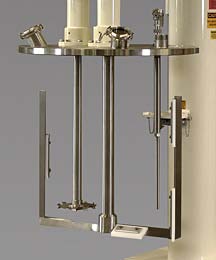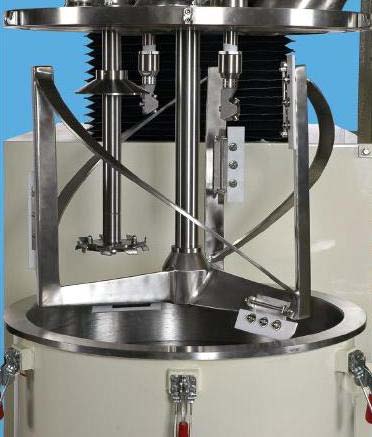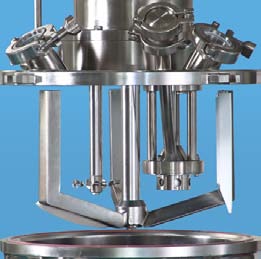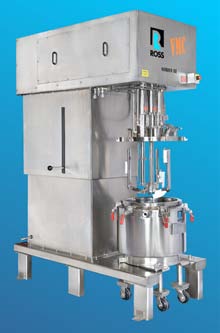Tech Report
Basics and benefits of dual-shaft mixers

Technology Brief
Dual-shaft mixers provide a combination of laminar agitation and high speed dispersive mixing robust enough to batch viscous solutions, dispersions, suspensions and emulsions that are several hundred thousand centipoise.
Dual-shaft mixers
The dual-shaft mixer is a versatile and cost-effective system used in the production of viscous formulations. It typically consists of a high speed saw-tooth disperser which can generate a strong vortex for rapid incorporation of solid ingredients into a liquid batch. Operated at tip speeds in the range of 500-5,000 ft/min, the disperser blade is commonly utilized to break down solid agglomerates and effectively "wet" each individual primary particle. Meanwhile, a low speed anchor agitator operated within a speed range of 50-500 ft/min supplies a steady exchange of materials from different parts of the vessel, essentially "feeding" the high speed disperser while constantly scraping the vessel sidewalls and bottom. Both agitators are independently driven and controlled such that they can be engaged in any combination and at any speed for any interval during the mixing cycle.
Viscosity range
By itself, a disperser blade produces acceptable flow patterns in fluids up to around 50,000 centipoise (cP). If viscosity continues to climb beyond this point, product turnover will eventually slow down and the batch will start to stagnate from around the vessel`s periphery. Product immediately surrounding the high speed blade could also overheat due to localized mixing.
In a dual-shaft mixer, the presence of the anchor agitator in addition to the disperser extends the viscosity range to several hundred thousand centipoise. Apparent static viscosity could be as high as a million centipoise or more but if the material is sufficiently shear-thinning, a robust disperser-anchor combination can produce adequate turnover during mixing and achieve a high level of dispersion. For example, a paste or gel material that is relatively non-flowable at rest but moves readily when agitated is a good application for a dual-shaft mixer.
When to use a dual-shaft mixer
Consider using a dual-shaft mixer for:
- Viscous applications up to approximately 1 million cP.
- High solids formulations. The disperser shaft can be equipped with two blades: one blade that is fixed at the lowest point of the shaft and another (of equal or smaller diameter) that is adjustable along the length of the shaft. The supplementary upper blade helps create a more powerful vortex to quickly draw large amounts of solid ingredients into the liquid phase. It is typically positioned one blade diameter below the liquid surface.
- Vacuum mixing requirements. The laminar bulk flow induced by the anchor in a dual-shaft mixer assists in breaking up air pockets within the batch during vacuum application. This helps to control the liquid level and prevent product from rising to the mixer cover.
- Sanitary or sensitive applications. Unlike counter-rotating mixers with bottom-entering agitators, dual-shaft mixers offer better protection against contamination because there are no agitator seals or bearings submerged in the product zone.
- Thick emulsions. A dual-shaft mixer equipped with an anchor agitator and a rotor/stator assembly (which could be interchangeable with the disperser blade) is recommended for viscous emulsions with relatively low solids content. A candidate formulation may be one that could be processed using a stand-alone rotor/stator but would benefit from improved temperature control or processing under vacuum. The impact could be as dramatic as cutting processing time in half, especially if a cooling cycle is involved.
Multi-Shaft Mixer Sample Configurations

Dual-Shaft Mixer composed of a two-wing anchor with scrapers and a saw-tooth disperser. A temperature probe through the mixer cover is also shown.

Dual-Shaft Mixer composed of a three-wing anchor with helical flights and scrapers, and a saw-tooth disperser with slinger. Two clean-in-place rotary spray nozzles are also shown.

Triple-Shaft Mixer composed of a three-wing anchor with a toriconical bottom profile,a saw-tooth disperser and a rotor/stator with powder induction manifold.
Dual-Shaft Mixers in the Food Industry

Ross Dual-Shaft Mixers are used throughout the food industry to prepare a variety of viscous formulations such as peanut butter, hummus paste, pizza and pasta sauces, nutritional supplements, gum dispersions, flavor emulsions, hydrocolloid suspensions, candies, syrups, dressings, condiments, pastry fillings, etc.